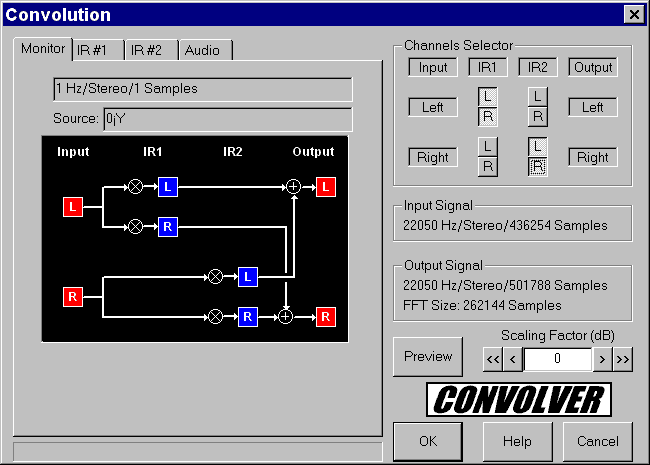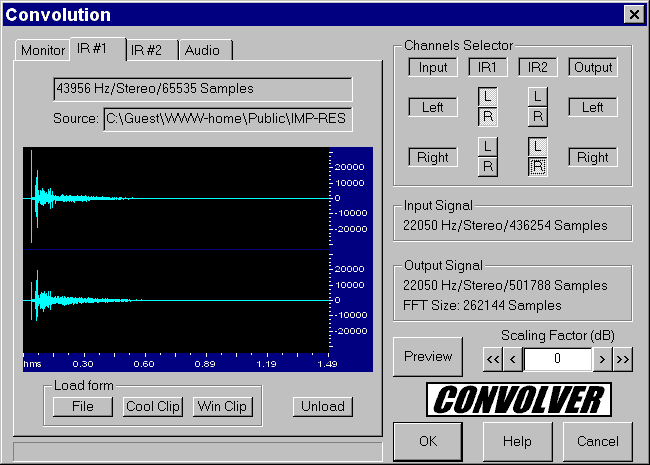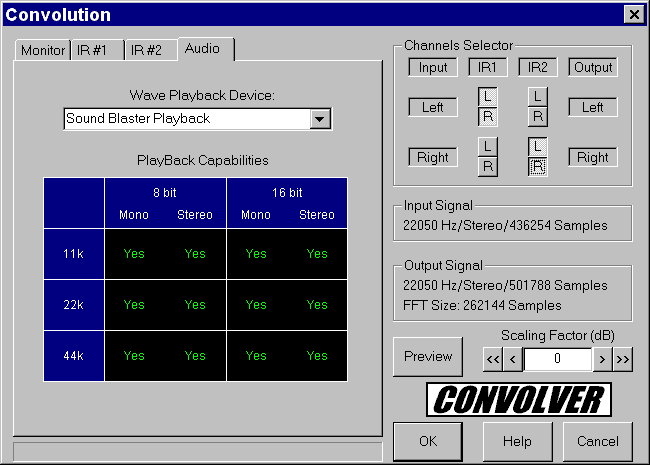|
|---|
Convolution is the mathematical operation which is required to "filter" an anechoic signal with an impulse response, obtaining a reverberated signal. If the process is performed simultaneously with a binaural (stereo) impulse response, the result is a stereo waveform which is capable of giving true three-dimensional acoustic imaging when listened through suitable headphones.
It is also possible to produce a realistic loudspeaker reproduction, provided that the listening environment is hemi-anechoic and that a proper cross-talk cancellation is implemented into the impulse responses to be convolved.
This is the user's interface of the Real Time Convolver, actually available as a plug-in for Cool Edit 96 and Cool Edit Pro:



Another older version of Aurora's Convolver exists, in the form of a transparent extension to the CoolEdit software.
Although specialised hardware capable of real-time convolution already exists (look at Lake DSP for this), Aurora makes use of a software-only solution: this means that all the computations (mainly very large FFTs and IFFTs with single precision float arithmetic) are made inside the CPU. Until yesterday it was impossible to get real-time convolution on a standard PC, but now this is no more true! We are pleased to announce that this new module can outperform DSP-based real-time convolvers, on a reasonably fast PC. As in the past, anyway, the user is free also to prepare pre-convoluted samples in short times: these samples can be played later to listening groups for subjective evaluations.
This table shows the real-time performance limits on the PCFARINA PC (Pentium Pro 200 Mhz, 256 k cache), working with 44.1 kHz waveforms:
| Description | N. of channels of the source signal |
N. of channels of the Impulse Response(s) |
Impulse Response Length (taps) |
|---|---|---|---|
| mono input with mono IR | 1 |
1 |
|
| mono input with stereo IR | 1 |
2 |
512,000 |
| stereo input with stereo IR | 2 |
2 |
300,000 |
| stereo input with 2 stereo IRs | 2 |
4 |
14,000 |
This table shows the real-time performance limits on a Pentium MMX 200 Mhz, working with 44.1 kHz waveforms:
| Description | N. of channels of the source signal |
N. of channels of the Impulse Response(s) |
Impulse Response Length (taps) |
|---|---|---|---|
| mono input with mono IR | 1 |
1 |
1,000,000 |
| mono input with stereo IR | 1 |
2 |
64,000 |
| stereo input with stereo IR | 2 |
2 |
16,000 |
| stereo input with 2 stereo IRs | 2 |
4 |
4,000 |